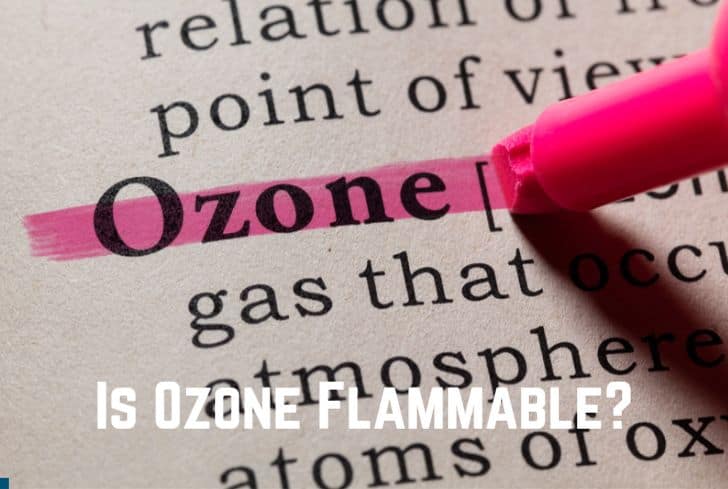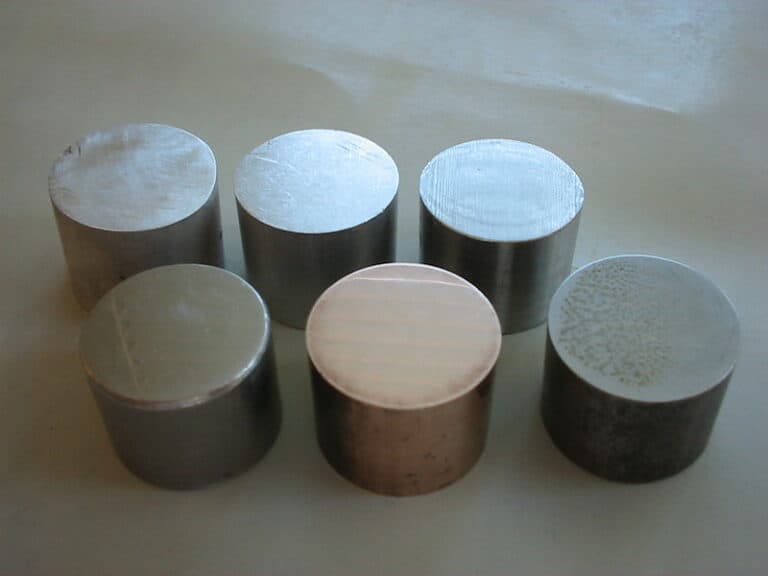Is Ozone Flammable? (It is Non-flammable)

Most people have probably heard the term “ozone layer” and may have questioned its meaning. Others have seen the ozone generator, primarily marketed as an air cleaner, and have wondered if it is safe. If you’re going to use an ozone machine, is ozone flammable?
Not only will you learn if ozone is flammable, but you’ll also discover what ozone is. We’ll let you know if ozone poses a fire risk or is damaging to electronics. Finally, you’ll learn more about ozone dangers and whether it is wise to keep an ozone machine in the same room.
Read: Is Borax Flammable? (Is It Safe to Burn in Fire?)
What is Ozone?
Ozone is a form of oxygen that has three oxygen atoms in one molecule. A single molecule of oxygen has two oxygen atoms. Ozone, on the other hand, is less stable and frequently breaks down in the atmosphere to generate regular oxygen. Ozone is blue, denser than air, and is formed naturally.
The outermost layer of the atmosphere, often known as the “ozone layer,” contains minimal traces of ozone. Ordinary oxygen gas, UV light, and electrical reactions combine naturally to create the gas. Ozone has a strong smell that is comparable to chlorine at higher concentrations.
Industrial-scale production of ozone gas is also carried out since it is a powerful oxidizing agent in chemical processes. The oxidizing agent is used to bleach textiles and food items and purify air and water. The gas is practically colorless when used in industrial applications.
Ozone is a gas that occurs naturally in the air. 90% of ozone gas is in the stratosphere, located 10–16 km (6–10 miles) above the globe’s surface. The troposphere, situated between the stratosphere and the surface of the earth, contains the remaining 10% ozone gas.
The gas protects us from the sun’s ultraviolet radiation and makes the air fresh after a thunderstorm. However, the gas is explosive in concentrated concentrations and reacts with many chemicals in modest doses.
Is Ozone Gas Flammable?
Ozone is a non-flammable gas. It is a type of oxygen that oxidizes, fuels fires, and can make other substances burn more intensely but is not itself combustible. Compared to an oxygen molecule, an ozone molecule has more oxygen. However, a flammable chemical must also be a fuel, not just an oxidant. Ozone cannot burn since it is not a fuel.
Ozone is oxygen, and ozone is not flammable since oxygen cannot react with oxygen. Additionally, unlike regular oxygen, it is unstable. The gas, which is heavier than air, breaks down when heated, releasing oxygen. When oxygen is produced, the gas will react violently with organic and non-organic compounds.
Is Ozone a Fire Hazard?
Ozone is a fire hazard. The gas doesn’t burn but can cause other materials to burn. Keep in mind that ozone, which has two oxygen atoms per molecule, will burn like ordinary oxygen. Ozone will serve as an oxidant, and when combined with other elements like fuel, heat, and chemical ignition, they will cause a fire to start.
Ozone will explode in the presence of the following conditions, whether in a solid, liquid, or gaseous state.
- Ozone explodes in the presence of abrupt changes in temperature or pressure.
- Heat or a spark exposure
- Presence of impurities.
The gas is a highly reactive molecule that can easily ignite and cause fires, as seen in this video. That’s how liquid ozone explodes!
Is Ozone Corrosive?
The gas ozone is quite corrosive. The gas is highly corrosive, especially when mixed with water. All yellow metals are more prone to corrosion as a result. Copper and galvanized metal pipes will corrode under the influence of ozone, causing leaks. A metal like silver tarnishes when exposed to air, mainly if the air contains high concentrations of ozone.
Read: How Long is Spilled Gas Flammable?
Is Ozone Odorless?
Ozone is not odorless. Its odor has been called the “smell of electricity” by some people. However, the smell is energy rather than electricity. Ozone is oxygen that has been intensely energetically charged. The atmospheric nitrogen and oxygen molecules are broken up into separate atoms by an electric charge, which can come from lightning or an electric generator.
Ozone is said to emit a fresh scent before it starts to rain. Nitric oxide, which occasionally interacts with other gases to form the molecule ozone, is created when some atoms combine once again. Ozone can reach human levels during thunderstorms downdrafts, which is the reason for the fresh smell before the rain starts to fall.
Greek word ozein (to smell)is where the term “ozone” originates. It is a beneficial source of oxidizing energy. Ozone will treat water when dissolved in it, and it will not affect the delicate tissue in your lungs.
Ozone, however, reportedly smells differently to different people. The following smells have also been used to describe ozone:
- Like a burning wire.
- Like chlorine.
- Metallic.
- Like an electric spark.
Is Ozone Harmful to Electronics?
Yes, ozone is harmful to electronics because it is a corrosive chemical. It will quickly shed that extra oxygen atom. Anything the ozone atom comes into contact with will then react with it. Parts of electronics react with oxygen quickly. These parts become damaged when exposed to ozone. Some electronics have rubber parts.
Rubber components in printers, loudspeakers, and other electromechanical devices are severely damaged by ozone. There is a condition known as ozone cracking, which is the attack of vulnerable rubbers by ozone. Before the introduction of preventative measures by the manufacturers, it was a condition that targeted tires.
The double bonds in rubber chains will be attacked by ozone gas. The following rubbers are easily degraded by ozone:
- Nitrile rubber.
- Styrene-butadiene rubber.
- Natural rubber.
- Polybutadiene.
- Butyl rubber is more resistant to ozone attack but still has several double bonds in its chains.
Electronics that come into touch with ozone do not permanently corrode, though. Electronics that are specifically made to function in ozone-rich conditions exist.
Is It Safe to Be in a Room With an Ozone Machine?
It is unsafe to be in the same room with an ozone machine. Ozone is a reactive chemical and can react with biological materials, human beings included. In humans, the gas can lead to serious respiratory issues. While a brief encounter with an ozone generator might not result in significant problems, continued exposure might be dangerous.
Households sometimes use ozone generators to filter the air. It is important to remember that you should never use it in places or at times when others can smell ozone. It will only take 10 to 90 minutes to clean up, depending on the size of the area. Inhaling ozone is dangerous in any amount.
Have you ever wondered how to use an ozone generator responsibly? Watch the video:
Dangers of an Ozone Generator
These are some of the signs of ozone poisoning that can help you identify if you have it:
- Respiratory infections are frequently encountered.
- Breathing difficulty.
- Chest discomfort and coughing.
- A worsening of your asthma symptoms.
- Irritation of the lips, eyes, nose, and skin.
- At higher exposure levels, there’s a chance of developing severe pneumonia.
- Central nervous system problems.
See a doctor immediately if you have an ozone generator at home and have noted any of the above symptoms.
Read: Is Blood Flammable?
Dangers of Ozone
Ozone is a gas with an offensive smell. Your health is likely to suffer as a result of gas exposure.
1. Dangers to your health
Your level of exposure will vary depending on how much and for how long you inhale. You’ll likely notice a minor headache, a dry cough, and shortness of breath after a brief exposure.
Ozone exposure over an extended period can cause more severe symptoms like fluid buildup in the lungs and a heavy feeling in the chest.
When you exercise or engage in outdoor activities, you may experience wheezing and breathing issues.
2. Danger to the environment
Plants and the ecosystem are likely to suffer from ozone’s harmful effects. The effect on the ability of plants to generate and store food is one of its most frequent adverse effects. The following adverse effects are more likely to happen to plants when they are unable to carry out those two functions:
- They will easily be affected by harsh weather.
- Certain diseases.
- Pollutants.
- Insects.
- Competition from other plants.
The presence of ozone will limit forest growth and crop yields. When these limits occur, they will impact species diversity in the ecosystem.
Ozone pollution will damage the plants in national parks, recreation areas, and cities. The leaves and other plants will suffer damage.
Read: Is Perfume Flammable?
Conclusion
Finding out that ozone is nothing more than oxygen with three oxygen molecules packed onto one atom has been interesting. Comparable to how oxygen, while not itself flammable, aids in the quicker ignition and faster burning of other substances. Therefore, it poses a fire hazard.
In contrast to oxygen, ozone is dangerous if you breathe it in for an extended period. It is likely to cause damage to electronics in your home. However, if you have an ozone generator in your home, we have given you symptoms to look out for and how to use it responsibly. Learn about the additional dangers of ozone from this article.






